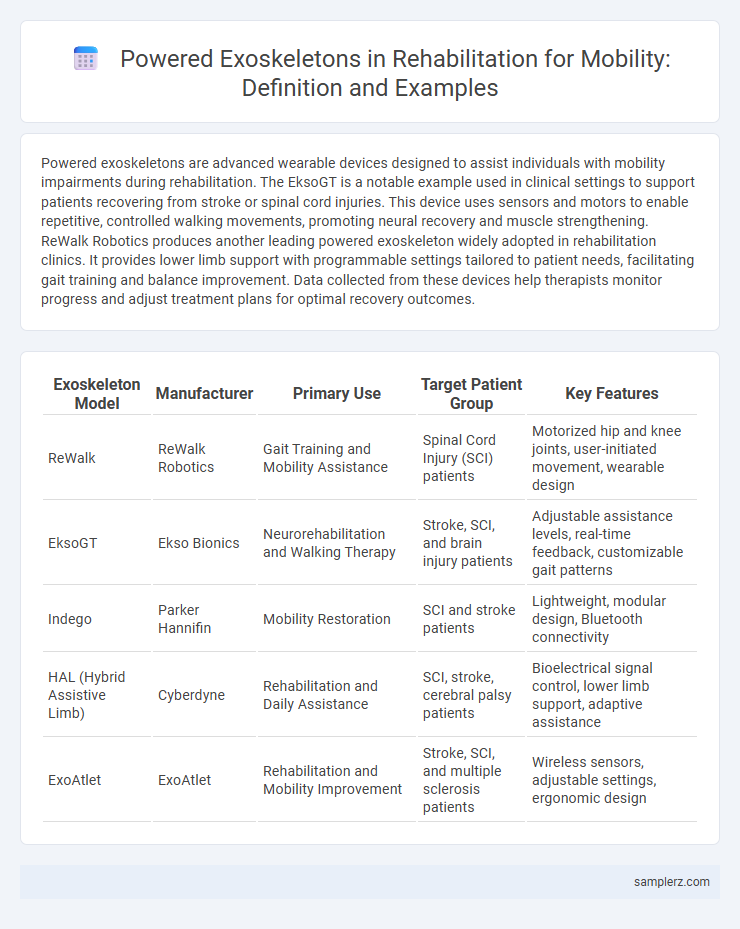Powered exoskeletons are advanced wearable devices designed to assist individuals with mobility impairments during rehabilitation. The EksoGT is a notable example used in clinical settings to support patients recovering from stroke or spinal cord injuries. This device uses sensors and motors to enable repetitive, controlled walking movements, promoting neural recovery and muscle strengthening. ReWalk Robotics produces another leading powered exoskeleton widely adopted in rehabilitation clinics. It provides lower limb support with programmable settings tailored to patient needs, facilitating gait training and balance improvement. Data collected from these devices help therapists monitor progress and adjust treatment plans for optimal recovery outcomes.
Table of Comparison
| Exoskeleton Model | Manufacturer | Primary Use | Target Patient Group | Key Features |
|---|---|---|---|---|
| ReWalk | ReWalk Robotics | Gait Training and Mobility Assistance | Spinal Cord Injury (SCI) patients | Motorized hip and knee joints, user-initiated movement, wearable design |
| EksoGT | Ekso Bionics | Neurorehabilitation and Walking Therapy | Stroke, SCI, and brain injury patients | Adjustable assistance levels, real-time feedback, customizable gait patterns |
| Indego | Parker Hannifin | Mobility Restoration | SCI and stroke patients | Lightweight, modular design, Bluetooth connectivity |
| HAL (Hybrid Assistive Limb) | Cyberdyne | Rehabilitation and Daily Assistance | SCI, stroke, cerebral palsy patients | Bioelectrical signal control, lower limb support, adaptive assistance |
| ExoAtlet | ExoAtlet | Rehabilitation and Mobility Improvement | Stroke, SCI, and multiple sclerosis patients | Wireless sensors, adjustable settings, ergonomic design |
Introduction to Powered Exoskeletons in Rehabilitation
Powered exoskeletons in rehabilitation represent cutting-edge technology designed to assist patients with mobility impairments by providing mechanical support and enhancing muscle activity during recovery. These wearable robotic devices facilitate repetitive motion and weight-bearing exercises, which are critical for neuroplasticity and functional restoration in conditions like spinal cord injury and stroke. Clinical studies demonstrate significant improvements in gait patterns, balance, and muscle strength when integrated into conventional physical therapy programs.
History and Evolution of Exoskeleton Technology
Powered exoskeleton technology in rehabilitation has evolved significantly since its inception in the 1960s with early mechanical prototypes designed to assist mobility-impaired individuals. Advances in robotics, sensor integration, and artificial intelligence have transformed these devices into sophisticated, adaptive systems used in clinical settings to enhance gait training and muscle strengthening. Milestones include the development of lightweight materials, improved battery life, and real-time biofeedback mechanisms, contributing to more effective and accessible rehabilitation solutions.
Key Principles of Powered Exoskeleton-Assisted Mobility
Powered exoskeletons in rehabilitation leverage key principles such as precise sensor integration for real-time movement detection and adaptive motor control to assist users with mobility impairments. These devices use biomechanical alignment and load distribution to ensure safe, natural gait patterns while promoting muscle activation and neuroplasticity. Advanced exoskeleton systems also incorporate user intent recognition through electromyographic signals to tailor assistance levels, enhancing functional recovery outcomes.
Notable Examples of Rehabilitation Exoskeletons
ReWalk Robotics is a notable example of powered exoskeletons used in rehabilitation, enabling paraplegic patients to achieve upright mobility and improve gait patterns. Ekso Bionics' EksoGT provides adjustable support for stroke and spinal cord injury patients, enhancing neuroplasticity during physical therapy. Indego exoskeleton offers modularity and ease of use, allowing patients to regain strength and balance through precise, controlled movements.
Lower Limb Exoskeletons for Gait Training
Lower limb exoskeletons, such as the EksoGT and ReWalk, are extensively used in rehabilitation to improve gait training for patients with spinal cord injuries and stroke. These powered devices assist in repetitive walking motions, enhance muscle activation, and promote neuroplasticity to restore mobility. Clinical studies demonstrate significant improvements in walking speed, balance, and endurance when incorporating these exoskeletons into therapy programs.
Upper Limb Exoskeletons for Arm and Shoulder Rehabilitation
Upper limb exoskeletons like the ArmeoSpring and MyoPro significantly enhance arm and shoulder rehabilitation by providing adjustable support and resistance tailored to individual patient needs. These powered devices enable precise movement assistance and resistance training, promoting muscle reactivation and neuroplasticity for stroke and spinal cord injury patients. Clinical studies demonstrate improved range of motion, strength, and functional recovery when integrating upper limb exoskeletons into rehabilitation protocols.
Pediatric Exoskeleton Applications in Physical Therapy
Pediatric powered exoskeletons are revolutionizing physical therapy by providing targeted support and enhancing mobility in children with neurological impairments such as cerebral palsy and spinal muscular atrophy. These wearable robotic devices enable repetitive, guided movements that promote neuroplasticity and muscle strengthening, accelerating motor function recovery. Clinical studies demonstrate significant improvements in gait patterns, balance, and overall independence, making exoskeletons a pivotal tool in pediatric rehabilitation protocols.
Integration of Exoskeletons in Post-Stroke Recovery
Powered exoskeletons have demonstrated significant benefits in post-stroke rehabilitation by enhancing motor function and promoting neuroplasticity through repetitive, controlled movement. These wearable robotic devices enable precise gait training and support patient-specific therapy protocols that accelerate recovery timelines. Clinical studies highlight improvements in walking speed, balance, and muscle strength when exoskeletons are integrated with conventional rehabilitation methods.
Clinical Benefits and Outcomes of Exoskeleton-Assisted Therapy
Exoskeleton-assisted therapy in rehabilitation significantly improves mobility and muscle strength in patients with spinal cord injuries and stroke. Clinical studies demonstrate enhanced gait patterns, reduced spasticity, and increased cardiovascular fitness, contributing to faster recovery and improved functional independence. Consistent use of powered exoskeletons accelerates neuroplasticity, promoting long-term motor function restoration and reducing the risk of secondary complications.
Future Trends in Exoskeleton Technology for Rehabilitation
Powered exoskeletons in rehabilitation are evolving with enhanced AI integration, enabling adaptive support tailored to individual patient biomechanics and recovery progress. Advances in lightweight, breathable materials improve user comfort and extended wearability, facilitating more effective therapy sessions. Future trends focus on combining real-time data analytics with cloud-based platforms to optimize personalized rehabilitation protocols and remote monitoring capabilities.

example of powered exoskeleton in rehabilitation Infographic
 samplerz.com
samplerz.com